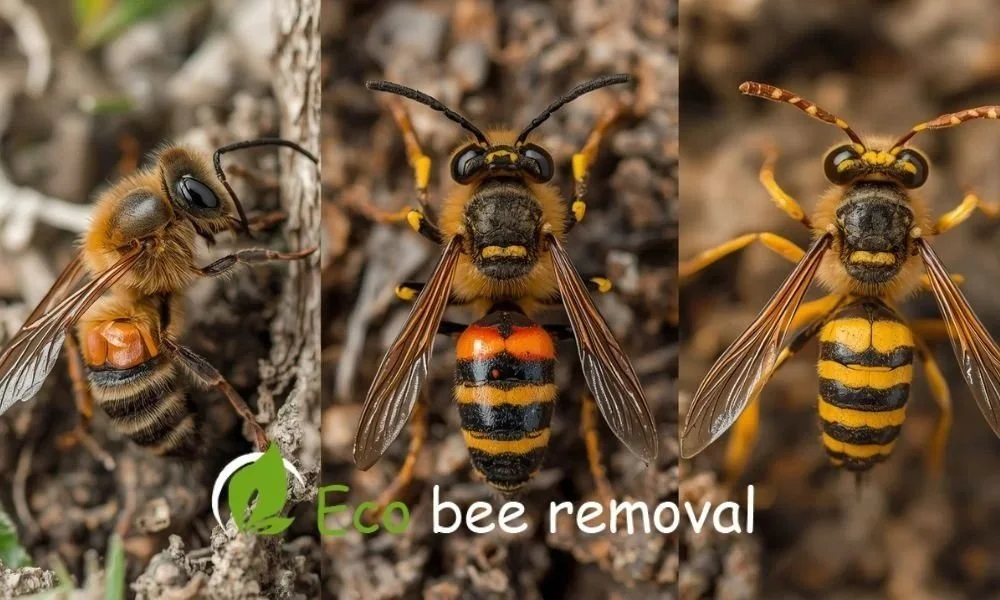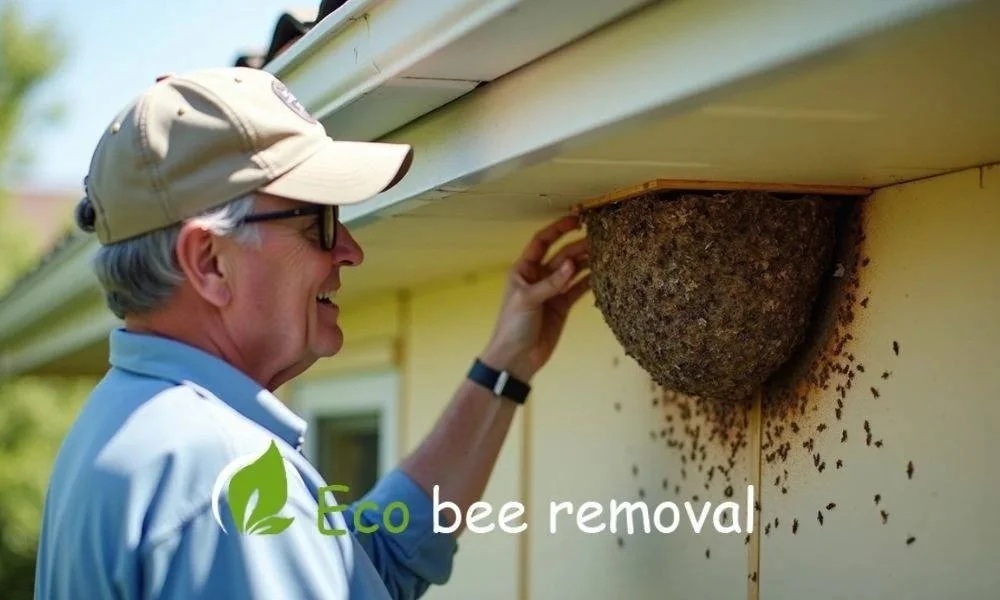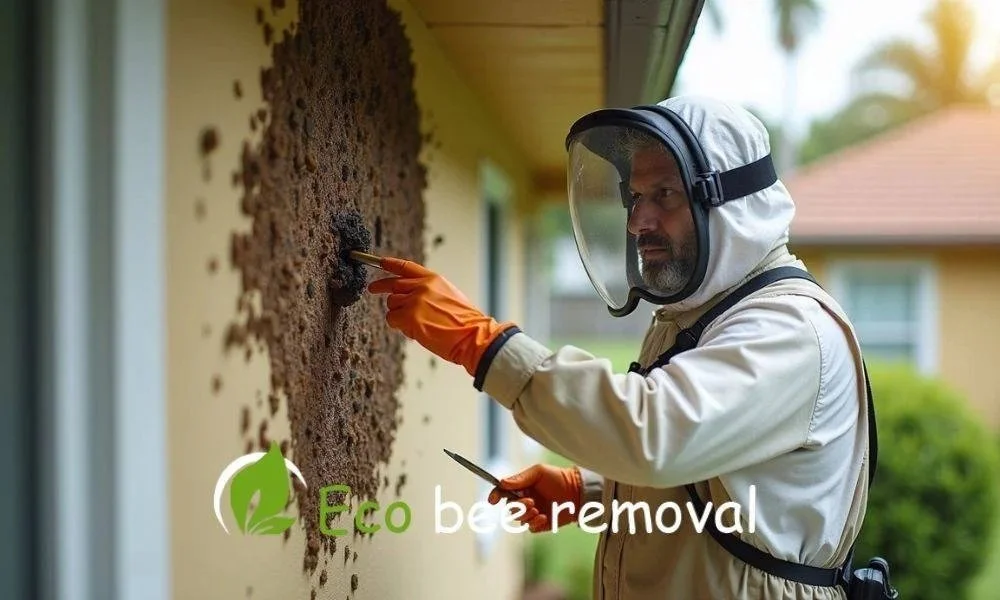Bee vs Wasp vs Hornet: How to Identify Them (And Why It Matters).
When you spot a flying insect buzzing near your roof, garden, or wall, your first thought might be, “Is that a bee, a wasp, or a hornet?” Most people can’t tell the difference—and that’s completely understandable. These stinging insects look similar at a glance, but they behave very differently.
Knowing how to identify bees, wasps, and hornets is more than just curiosity. It can protect your family, prevent damage to your property, and even help preserve vital pollinators.
At Eco Bee Removal, we’re experts in recognizing and safely removing these insects from homes across Florida. Here’s how you can tell them apart and what to do if they’ve made a nest near you.
🐝 Understanding Bees: The Gentle Pollinators
Bees are nature’s hard-working pollinators. They’re typically fuzzy, round-bodied, and covered in fine hair that collects pollen as they move from flower to flower. Most bees have black and yellow stripes, although some species, such as carpenter bees, are shiny and mostly black.
Bee vs Wasp vs Hornet side-by-side comparison for easy identification.
Behavior and Temperament
Bees are non-aggressive by nature. They usually sting only when they feel threatened or when their hive is disturbed. Honeybees, in particular, can sting just once, as they die afterward. Their focus is on pollination and collecting nectar—not on confrontation.
Nesting Habits
Different bee species build different types of homes.
Honeybees often live in large wax comb hives, sometimes found inside tree hollows, wall cavities, or attics.
Bumblebees prefer nesting in the ground or abandoned animal burrows.
Carpenter bees drill small, round holes into wood to create tunnels where they lay eggs.
If you notice bees frequently entering a small opening in your wall or roofline, there’s likely a hive inside. Avoid blocking the entrance—this can trap bees inside and cause damage.
Why Bees Are Important
Bees are essential to our ecosystem. About one-third of all crops we eat depend on pollination, and bees do most of the work. That’s why it’s critical to relocate bees humanely instead of exterminating them. Eco Bee Removal specializes in live bee relocation, helping save these vital pollinators while keeping your home safe.
🐞 Wasps: The Sleek and Often Aggressive Hunters
Wasps are slimmer, shinier, and more elongated than bees. They have a distinct, narrow waist and little to no body hair. Their bright yellow and black stripes give them a warning look, signaling “stay away.”
Behavior and Diet
Unlike bees, wasps are predators. They feed on other insects, meat, and sugary drinks, which explains why they often appear near trash bins, picnic areas, or outdoor kitchens.
Wasps can sting multiple times, and some species—like yellowjackets—are highly aggressive, especially when defending their nests. Even loud noises or vibrations can trigger an attack, so caution is key.
Common Nesting Spots
Wasps build their nests from paper-like material made by chewing wood fibers mixed with saliva. You’ll often find their nests under roof eaves, deck railings, or even in shrubs.
Paper wasps create umbrella-shaped nests with open combs.
Yellowjackets may nest underground, in wall voids, or behind siding.
Mud daubers form small mud tubes on walls, garages, and porches.
If you see a papery structure forming around your home, act early. A small wasp nest in spring can grow into a large colony by summer. Professional wasp removal ensures safety and prevents recurrence.
🦟 Hornets: The Larger and More Powerful Wasps
Hornets are actually a subspecies of wasp, but they’re larger, louder, and often more intimidating. They can grow over an inch long, with black-and-white or reddish-brown coloration.
Behavior and Temperament
Difference between bee beehive and a wasp nest near a home structure.
Hornets are generally less aggressive than yellowjackets unless their nest is disturbed. However, their sting is more painful and potentially dangerous for people allergic to venom. Because hornets live in larger colonies, they defend their nests fiercely when threatened.
Nesting Preferences
Hornets build enclosed, football-shaped paper nests that hang from tree branches, roofs, or attic spaces. These nests can contain hundreds of workers by late summer. Trying to remove a hornet nest yourself can be risky—professional help is strongly advised.
At Eco Bee Removal, we handle hornet nests safely and humanely using eco-friendly methods that protect your property and prevent regrowth.
🧠 Bee vs Wasp vs Hornet: How to Tell the Difference Without a Chart
Even without a comparison table, you can quickly spot key differences by observing a few traits:
Body shape: Bees look round and fuzzy; wasps are sleek and shiny; hornets are large and robust.
Temperament: Bees are gentle pollinators; wasps are aggressive hunters; hornets are defensive and territorial.
Sting behavior: Bees sting once and die; wasps and hornets can sting repeatedly.
Nest material: Bees use wax; wasps and hornets use a papery pulp made from chewed wood.
Role in nature: Bees pollinate plants; wasps and hornets help control pest insects.
Identifying which insect you’re dealing with helps you make the right decision—whether it’s safe relocation for bees or careful removal for wasps and hornets.
🚨 Why Correct Identification Is So Important
Mistaking a beehive for a wasp or hornet nest can lead to serious problems. Using insecticides or disturbing the wrong species can harm or kill vital pollinators or provoke an aggressive swarm.
Here’s why correct identification matters:
Safety: Wasps and hornets can attack in groups if threatened.
Environmental protection: Bees should always be relocated, not exterminated.
Long-term results: Each species requires a different removal method for effective prevention.
If you’re unsure what species is nesting near your property, don’t take chances. Call a licensed professional to inspect and handle the situation safely.
🌿 Eco-Friendly Removal and Relocation
At Eco Bee Removal, we take pride in using non-toxic, environmentally safe techniques to remove bees, wasps, and hornets. Our trained specialists carefully relocate bees to local beekeepers or conservation areas, where they can continue pollinating crops and wildflowers.
For wasps and hornets, we use gentle yet effective methods to eliminate nests without harming nearby wildlife or contaminating your environment. Our approach ensures that your home stays safe while nature remains balanced.
Whether you have bees in your wall, wasps under your deck, or hornets in a tree, our experts provide fast, humane, and lasting solutions across Florida — including Miami, Fort Myers, Cape Coral, and Sarasota.
🏡 Prevention Tips: Keep Bees, Wasps, and Hornets Away
Eco-friendly bee and wasp removal professional sealing home entry points
Prevention is always better than removal. You can greatly reduce the risk of stinging insects nesting near your home by following these simple steps:
Seal entry points: Check rooflines, attic vents, and wall gaps. Seal small holes with caulk or mesh.
Keep food covered: Sweet drinks, ripe fruit, and open garbage attract wasps and hornets.
Inspect regularly: During spring, look for early nest-building activity around your porch or shed.
Limit strong scents: Perfumes, sugary beverages, and bright clothing can attract flying insects.
Call professionals early: If you notice unusual buzzing or hive activity, schedule an inspection before the problem grows.
By being proactive, you can avoid infestations and protect both your home and the pollinators that keep nature thriving.
🌎 Final Thoughts
Bees, wasps, and hornets each play an important role in the environment, but they become a problem when they build nests too close to people. Recognizing which insect you’re dealing with helps you respond correctly — protecting your home, your family, and the planet.
Bees deserve relocation and protection.
Wasps require careful control.
Hornets demand safe, professional removal.
At Eco Bee Removal, we handle all three with precision, care, and respect for nature.
📞 Call us today at (888) 282-1886 for eco-friendly bee, wasp, or hornet removal in your area.
🌐 Visit www.ecobeeremoval.com to learn more about our humane methods and see why homeowners across Florida trust us for safe, sustainable pest control.



